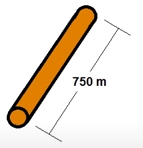How To Find The Area Of A Wire
How to Calculate Wire Diameter & Cross-Sectional Expanse
In this blog, we will review the concept of resistance, resistivity and steps to calculate the minimum cross-exclusive area and diameter of whatever desired conductor.
What is Resistance?
The property of a device or a circuit that opposes the move of current through it. Resistance is measured in Ohms (Ω). The resistance of whatsoever material with a uniform cross-sectional area is determined by the following four factors:
- The kind of material
- The length
- The cantankerous-sectional area
- The temperature
What is Resistivity?
Resistivity is the measure of how much a given size of specific material resists the current flow. While materials resist electrical electric current flow, some are better at conducting it than others. Resistivity is used to compare the inherent resistance characteristics of unlike materials. Materials that hands conduct electric current are referred to as conductors. Conductors have a low resistivity. While the materials that do not easily conduct current are referred to as insulators. Insulators have a high resistivity. The resistivity of a material plays an of import role in choosing the materials used for electric wire.
Now that we empathise the concept of resistance and resistivity clearly, let's review the general human relationship of basic usher resistance, which suggests that the resistance of a given conductor is equal to the material resistivity times the ratio of its length to its cross-sectional area. This can assistance us to summate the minimum cantankerous-sectional area and diameter of any desired conductor.
Permit's work out an example to understand the steps to calculate the minimum cross-sectional area and bore of any desired usher.
Example: What is the minimum cross-sectional area and diameter of conductor for a 750-meter-long copper wire having a maximum resistance of 0.ii ohms?
Minimum Cross-exclusive Area:
To solve this problem, we volition use the full general relationship for computing conductor resistance using the formula beneath:
Resistance = Resistivity * (Length / Area )

R =
R = Resistance of cloth, in Ohms
Ρ = Material Resistivity, in Ohms per meter
Fifty = Conductor Length, in meters
A = Cross-sectional Surface area, in square meters
In order to use this general relationship to solve our instance trouble, we require the specific resistance or resistivity of copper. Annotation that we acquire the resistivity of conductor materials from the table of conductor resistivity and nosotros know now that copper has a resistivity of ane.72 x 10e-viii ohms per meter.
While solving Conductor Resistance, remember to express resistance in ohms, material resistivity in ohms per meter, conductor length in meters, and cross-sectional surface area in square meters for this relationship to be valid. We can so move on to summate the cross-exclusive surface area of the wire past substituting for the known quantities in the example.
A = Eq. (1)
Diameter of the conductor:
Surface area of a circumvolve can be represented using below formula. We will take to rearrange the formula to solve for diameter.
A =
4*A =
=
d =
We can at present substitute our acquired cross-sectional area value from Eq. (1) into this relationship and calculate the bore of the copper wire to go far at a bore of 0.009062 meters.
d =
d = (8.212395*10-5)0.five
d = 0.009062 g
Now that we have the solution values, we will convert them and express our final answer using the standard units.
A =
d = 0.009062 1000 = ix.062 mm
Thereby, nosotros conclude that our copper wire must have a minimum cross-sectional area of no less than 64.v mm^2 and a bore of no less than 9.062 mm.
Source: https://www.etcourse.com/news-blog/how-calculate-wire-diameter-cross-sectional-area
Posted by: brownspoks1979.blogspot.com


0 Response to "How To Find The Area Of A Wire"
Post a Comment